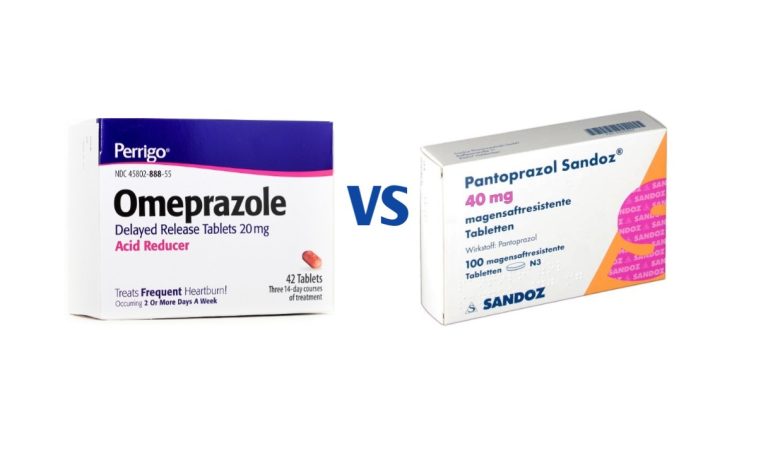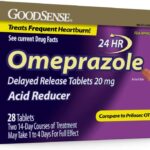Omeprazole vs. Pantoprazole: Differences & Similarities

Omeprazole and pantoprazole, both generic medications falling under the proton pump inhibitor (PPI) class, are commonly prescribed to manage heartburn and digestive conditions such as gastroesophageal reflux disease (GERD) and erosive esophagitis.
While these medications share similarities in their mechanism of action, the question remains: is one more advantageous than the other? This article explores the nuances of omeprazole and pantoprazole, shedding light on their differences and similarities.
Understanding Proton Pump Inhibitors (PPIs)
Omeprazole and pantoprazole belong to the class of drugs known as proton pump inhibitors (PPIs), designed to block acid production in the stomach. Recognized as safe and equally effective, they represent a first-line treatment for GERD when compared to alternatives like H2 antagonists. Despite their commonalities, distinctions exist between these generic medications, influencing factors such as conditions treated, availability, and cost.
Distinguishing Between Omeprazole and Pantoprazole
Omeprazole, the generic version of Prilosec, gained FDA approval in 1989 and was a pioneer in the PPI category. With availability in both prescription and over-the-counter (OTC) forms, omeprazole treats conditions such as GERD, erosive esophagitis, peptic ulcers, and Zollinger-Ellison syndrome. In contrast, pantoprazole, known as Protonix, received FDA approval in 2000 and is exclusively available by prescription. It addresses erosive esophagitis associated with GERD and plays a role in the long-term treatment of Zollinger- Ellison syndrome.
Key Differences
Omeprazole and pantoprazole, although sharing similar therapeutic uses in managing conditions related to excess stomach acid, exhibit noteworthy distinctions that merit closer consideration.
1. Availability and Dosage:
• Omeprazole: Distinguished by its dual accessibility, omeprazole is available both over-the-counter and by prescription, providing users with the flexibility to choose the most convenient means of obtaining the medication. The over-the-counter availability of omeprazole contributes to its widespread use for self-management of mild symptoms, empowering individuals to address occasional heartburn without a prescription.
• Pantoprazole: In contrast, pantoprazole is exclusively available with a prescription, necessitating a healthcare provider’s intervention for acquisition. Furthermore, it comes in time-released capsules or an oral suspension, allowing for varied administration methods based on individual preferences or medical considerations.
2. Pediatric Use:
• Omeprazole: The approval for pediatric use begins at one year of age, indicating its suitability for a broader age range, including infants and toddlers. This makes omeprazole a viable option for addressing stomach acid-related conditions in younger children, aligning with the diverse needs of pediatric patients.
• Pantoprazole: Pediatric use of pantoprazole is limited to children aged five and above, potentially restricting its application in younger age groups. The higher age requirement may influence healthcare providers’ decisions when considering treatment options for pediatric patients.
3. Cost:
• Omeprazole: The cost of omeprazole fluctuates, ranging from approximately $9 to $60 for a 30-day supply. This variability in pricing allows for potential cost savings based on individual financial considerations, making it a financially accessible option for a diverse range of patients.
• Pantoprazole: Slightly more affordable than omeprazole, pantoprazole’s cost falls within the range of $9 to $50 for a 30-day supply. The cost-effectiveness of pantoprazole may be a deciding factor for individuals seeking an economical yet efficacious solution for managing stomach acid-related conditions.
Despite these differences in accessibility, pediatric approval, and cost, it is crucial to emphasize that both medications maintain a high level of safety and efficacy within their intended uses. Patients can work collaboratively with healthcare providers to assess individual needs, preferences, and financial considerations, ensuring the selection of the most suitable medication for optimal therapeutic outcomes.
Omeprazole in Detail
Omeprazole, a trailblazer in the PPI realm, was initially available only by prescription. The FDA approved an OTC version in 2015, expanding accessibility. Omeprazole is available in delayed-release capsules or dissolvable powder, with dosages ranging from 10 mg to 60 mg. It takes effect within an hour, reaching its full potential after four days.
Main FDA-Approved Uses of Omeprazole
1. GERD: Treats and improves frequent heartburn and other GERD symptoms.
2. Erosive Esophagitis: Controls symptoms and facilitates rapid healing.
3. Gastric and Duodenal Ulcers: Prevents and heals ulcers by neutralizing stomach acid.
4. Zollinger-Ellison Syndrome: Manages this rare condition characterized by tumors in the pancreas and small intestine.
5. H. pylori: Aids in healing damage caused by H. pylori bacteria in the stomach when used alongside antibiotics.
6. Upper Gastrointestinal Bleeding: An important therapy to prevent GI bleeds, especially in high-risk patients.
Omeprazole Side Effects
While generally safe, common side effects include headache, abdominal pain, nausea, vomiting, diarrhea, and gas. Rare but serious side effects may include chronic kidney disease, pancreatitis, and liver damage. Patients with underlying health conditions may experience less common side effects like bone fractures or chronic stomach inflammation.
Omeprazole Drug Interactions
Omeprazole may interact with various medications, including antiretrovirals, blood thinners, and organ transplant medications. Consultation with a healthcare provider is essential, especially for individuals taking multiple medications.
Pantoprazole in Detail
Pantoprazole, also known as Protonix, entered the market in 2000 and mirrors omeprazole in its ability to manage GERD and associated complications. When it comes to how long pantoprazole takes to work, a 2018 study found significant symptom relief in 45% of GERD patients after four weeks of pantoprazole use, with close to 70% experiencing improvement after eight weeks.
Main FDA-Approved Uses of Pantoprazole
1. GERD: Manages and relieves GERD symptoms.
2. Erosive Esophagitis: Maintains healing of esophageal ulcers and prevents recurrence.
3. Zollinger-Ellison Syndrome: Long-term treatment for this rare condition leading to gastric ulcers.
Off-Label Uses
In addition to its FDA-approved indications, pantoprazole exhibits versatility in off-label applications, showcasing its potential in addressing various medical conditions:
1. H. pylori Infections: Pantoprazole is occasionally utilized off-label in combination with antibiotics to address infections caused by Helicobacter pylori (H. pylori). By aiding in the eradication of the bacteria, pantoprazole contributes to the comprehensive management of gastrointestinal issues associated with H. pylori.
2. Prevention of NSAID-Induced Ulcers: Off-label, pantoprazole is employed as a preventive measure against ulcers induced by nonsteroidal anti-inflammatory drugs (NSAIDs). By mitigating the erosive effects of NSAIDs on the gastrointestinal tract, pantoprazole adds an extra layer of protection for individuals requiring prolonged NSAID therapy.
3. Inhibition of Rebleeding in Peptic Ulcers: Pantoprazole demonstrates off-label efficacy in inhibiting rebleeding of peptic ulcers. This application is particularly relevant for individuals who have experienced peptic ulcers and are at risk of recurrent bleeding. By promoting healing and reducing the likelihood of rebleeding, pantoprazole contributes to a more sustained and favorable clinical outcome.
Pantoprazole Side Effects
Common side effects include nausea, diarrhea, vomiting, bloating, and joint pain. Serious side effects are rare but may include allergic reactions necessitating immediate medical attention. Long-term use may be associated with a higher risk of kidney problems, bone fractures, and memory loss.
Drug Interactions with Pantoprazole
Studies indicate that pantoprazole exhibits a lower frequency of drug interactions compared to omeprazole. While the incidence of significant drug interactions with pantoprazole is relatively low, it remains crucial to consider these interactions, especially for patients concurrently using multiple medications.
Although not an exhaustive list, the following are notable drug interactions to be mindful of when taking pantoprazole:
1. Certain Antiretrovirals: Pantoprazole may interact with specific antiretrovirals, medications utilized in the treatment of HIV infection. Patients on antiretroviral therapy should exercise caution and consult their healthcare provider to ensure compatibility with pantoprazole.
2. Warfarin, a Blood Thinner: Combining pantoprazole with warfarin, a blood-thinning medication, may substantially elevate the risk of bleeding. Individuals prescribed warfarin should communicate with their healthcare provider about potential interactions before incorporating pantoprazole into their medication regimen.
3. Methotrexate: The concurrent use of pantoprazole and methotrexate can heighten the risk of methotrexate toxicity. Patients prescribed methotrexate, a medication employed in the treatment of various conditions such as arthritis and cancer, should discuss potential interactions and closely monitor their health under the guidance of a healthcare professional.
Considerations for Use
While generally safe, omeprazole and pantoprazole have considerations for specific populations:
1. Pediatric Use: Omeprazole is considered safe for children over one year, whereas pantoprazole is prescribed for children aged five and above.
2. Pregnancy and Nursing: Adequate studies on risks for pregnant or nursing women are lacking for both drugs.
3. Prolonged Use Risks: Long-term use of PPIs, including omeprazole and pantoprazole, may be associated with increased risks of adverse effects, necessitating caution and regular reassessment.
Conclusion
Choosing between taking omeprazole or pantoprazole involves weighing factors such as availability, cost, and individual health considerations. While both medications are recognized as safe and effective, personalized medical advice remains crucial to navigate potential side effects, drug interactions, and overall suitability. Engaging in open communication with a healthcare provider ensures informed decision-making, optimizing the balance between health needs and treatment efficacy.





